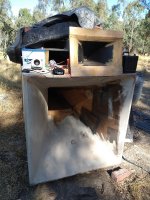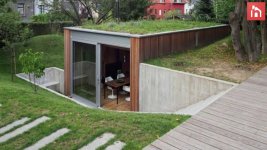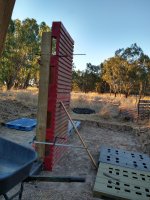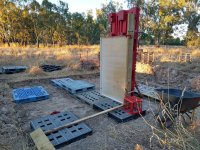My current bush system is pictured. It is based around a 60Hz expo horn. Made ~4 years ago, still only half painted 🙂
I'm building a small "shed" / listening room, on the same (unpowered) bush block.
- size must be small, about 25 cubic metres.
- will mainly be re-use existing audio gear - I have a stack of pro audio woofers etc in my shed.
- efficiency must be decent because I'm using battery power.
- I'd like it to sound like the outdoor system (no reflections / room modes) ...but indoors.
I'd like to embed as many ideas as possible at the design + build stage.
That is, instead of making a normal wall and then tacking on a small acoustic panel, I'd much rather build a wall that IS an acoustic panel.
I'd like the room to be earth embedded - not underground, but with a green roof + bermed walls. The 2nd attached picture is the sort of thing I'm considering (example found in a google image search)*
I'm considering how best to embed room treatment within that.
(a) LF: active, via some sort of double bass array
Double Bass Array (DBA) - The modern bass concept! | AVS Forum
...but in my case, the rear of the array can be a horn, or infinite baffle or big cabinet of whatever type.
(b) midbass and above: passive room treatment built into other walls, floor and ceiling.
For the latter, I have acquired a (literal) truckload of panels: 13 perforated metal sheets (most are just over 1mx2m, as seen in 4th picture) plus a couple of smaller panels and about 100 plastic pallets (several types, with most being cold room / hygiene panels like this: Vicfam Plastics: Hygiene Pallet ).
I'll use these to "skin" the structure. Most of the inside surfaces will be perforated panels, with stuffed voids between the perforated layer and the solid external skin. The third + fourth picture show a mockup of how I might do this.
Given these constraints / options / materials / ideas, got any tips?
Can y'all recommend good design articles that specifically address small, heavily treated spaces?
* for multiple reasons:
- as a test run for this type of build
- for comfort (heat)
- for aesthetics
- for acoustics (low frequency boost via "room gain")
I'm building a small "shed" / listening room, on the same (unpowered) bush block.
- size must be small, about 25 cubic metres.
- will mainly be re-use existing audio gear - I have a stack of pro audio woofers etc in my shed.
- efficiency must be decent because I'm using battery power.
- I'd like it to sound like the outdoor system (no reflections / room modes) ...but indoors.
I'd like to embed as many ideas as possible at the design + build stage.
That is, instead of making a normal wall and then tacking on a small acoustic panel, I'd much rather build a wall that IS an acoustic panel.
I'd like the room to be earth embedded - not underground, but with a green roof + bermed walls. The 2nd attached picture is the sort of thing I'm considering (example found in a google image search)*
I'm considering how best to embed room treatment within that.
(a) LF: active, via some sort of double bass array
Double Bass Array (DBA) - The modern bass concept! | AVS Forum
...but in my case, the rear of the array can be a horn, or infinite baffle or big cabinet of whatever type.
(b) midbass and above: passive room treatment built into other walls, floor and ceiling.
For the latter, I have acquired a (literal) truckload of panels: 13 perforated metal sheets (most are just over 1mx2m, as seen in 4th picture) plus a couple of smaller panels and about 100 plastic pallets (several types, with most being cold room / hygiene panels like this: Vicfam Plastics: Hygiene Pallet ).
I'll use these to "skin" the structure. Most of the inside surfaces will be perforated panels, with stuffed voids between the perforated layer and the solid external skin. The third + fourth picture show a mockup of how I might do this.
Given these constraints / options / materials / ideas, got any tips?
Can y'all recommend good design articles that specifically address small, heavily treated spaces?
* for multiple reasons:
- as a test run for this type of build
- for comfort (heat)
- for aesthetics
- for acoustics (low frequency boost via "room gain")
Attachments
Last edited:
Replying to myself, because I have got a clue about one of the acoustic issues:
(a) LF: active, via some sort of double bass array.
---
In this setting, there is a better option.
In a double bass array, the front array "throws" the bass, the back array "catches" the bass, and there is therefore less room influence on the sound quality.
A double bass array is essentially a way making it appear that a room has no wall behind the listener.
In my situation, I can actually have no wall behind the listener.
In practice, if I make that wall from materials that are transparent at low frequencies ( a core of bagged insulation batts inside a skin of perforated steel), I'll get something that is a wall for the purposes of comfort + aesthetics, but that is transparent to bass.
(a) LF: active, via some sort of double bass array.
---
In this setting, there is a better option.
In a double bass array, the front array "throws" the bass, the back array "catches" the bass, and there is therefore less room influence on the sound quality.
A double bass array is essentially a way making it appear that a room has no wall behind the listener.
In my situation, I can actually have no wall behind the listener.
In practice, if I make that wall from materials that are transparent at low frequencies ( a core of bagged insulation batts inside a skin of perforated steel), I'll get something that is a wall for the purposes of comfort + aesthetics, but that is transparent to bass.
It sounds like you could essentially make the whole room acoustically transparent down low and absorptive further up. That would sound a lot like listening outdoors. Are thermal considerations an issue?
I would place the bass section very close to the listener for maximum impact with minimum power.
I would place the bass section very close to the listener for maximum impact with minimum power.
"It sounds like you could essentially make the whole room acoustically transparent down low and absorptive further up."
I could, but I was thinking that making most of the walls opaque to bass might be better cos:
(a) it will give me some LF gain, relative to a free air setup.
(b) I'd like to make the structure earth sheltered, like the 2nd picture, which is not consistent with acoustically transparent 🙂
"Are thermal considerations an issue?"
Electronically, no - this is a very low power rig.
Environmentally, yes. I get the same heatwaves that you do, which is why I'm interested in earth berms etc (low tech air conditioning).
"I would place the bass section very close to the listener for maximum impact with minimum power."
If I abandon the bass array concept, going near field with the sub would indeed be a good plan.
With a bass array, as I envisage it, listening distance is moot.
A bass array at one end of a room with parallel walls = a plane wave travelling down a tube, like a stethoscope. There would be essentially no losses with distance.
For extra info: this is the same guy I linked in post one, but this thread is him building a single bass array (he replaced the rear wall array with a 65 cm deep acoustic sponge).
He seems to have achieved lots of room gain, without lots of room issues (the FR plot and waterfall in post 19 looks good).
Single Bass Array with massive damping (measurements inside) - Gearslutz
My guess is that a semi-open wall would work even better at eating room modes.
I could, but I was thinking that making most of the walls opaque to bass might be better cos:
(a) it will give me some LF gain, relative to a free air setup.
(b) I'd like to make the structure earth sheltered, like the 2nd picture, which is not consistent with acoustically transparent 🙂
"Are thermal considerations an issue?"
Electronically, no - this is a very low power rig.
Environmentally, yes. I get the same heatwaves that you do, which is why I'm interested in earth berms etc (low tech air conditioning).
"I would place the bass section very close to the listener for maximum impact with minimum power."
If I abandon the bass array concept, going near field with the sub would indeed be a good plan.
With a bass array, as I envisage it, listening distance is moot.
A bass array at one end of a room with parallel walls = a plane wave travelling down a tube, like a stethoscope. There would be essentially no losses with distance.
For extra info: this is the same guy I linked in post one, but this thread is him building a single bass array (he replaced the rear wall array with a 65 cm deep acoustic sponge).
He seems to have achieved lots of room gain, without lots of room issues (the FR plot and waterfall in post 19 looks good).
Single Bass Array with massive damping (measurements inside) - Gearslutz
My guess is that a semi-open wall would work even better at eating room modes.



